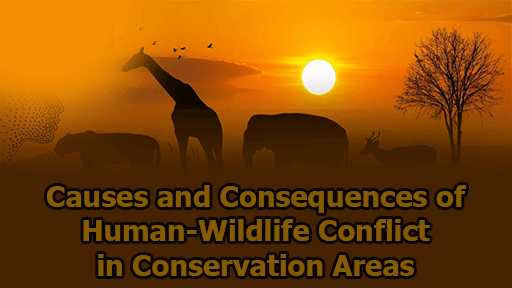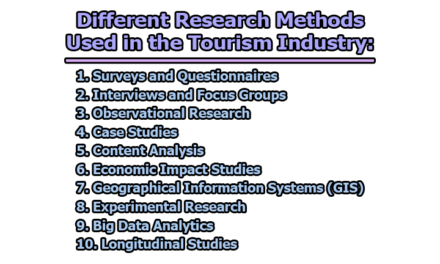Causes and Consequences of Human-Wildlife Conflict in Conservation Areas:
Human-Wildlife Conflict (HWC) occurs when the needs and behavior of wildlife negatively impact human activities, and vice versa. This conflict has become a significant issue in conservation areas, where human populations are increasingly encroaching on wildlife habitats. As the world’s population grows and natural habitats shrink, competition between humans and wildlife for resources such as land, water, and food has intensified (Nyhus, 2016). These conflicts not only threaten wildlife conservation efforts but also disrupt local communities’ livelihoods, often leading to economic, social, and ecological consequences. Understanding the causes of these conflicts is essential for implementing effective strategies that mitigate their impact and promote coexistence between humans and wildlife. Here, we are going to know the causes and consequences of Human-Wildlife Conflict in conservation areas.
Causes of Human-Wildlife Conflict:
1. Habitat Loss and Fragmentation: Habitat loss and fragmentation are among the primary drivers of human-wildlife conflict. As human populations expand, natural habitats are destroyed to make way for agriculture, infrastructure development, and urbanization (Woodroffe et al., 2005). This forces wildlife into smaller, fragmented areas where they are more likely to come into contact with humans.
Example: In Southeast Asia, deforestation for palm oil plantations has reduced the available habitat for elephants, forcing them to forage in agricultural areas where they destroy crops (Wilson et al., 2015).
2. Human Encroachment into Wildlife Areas: Human encroachment into conservation areas is another significant factor contributing to HWC. When people settle or farm in areas that were previously wildlife habitats, conflicts arise as animals attempt to reclaim their territory or access resources (Thirgood et al., 2005).
Example: In parts of Africa, pastoral communities often graze livestock in protected areas, leading to conflicts with predators such as lions and leopards, which prey on the livestock (Hemson et al., 2009).
3. Competition for Natural Resources: Humans and wildlife often compete for the same resources, particularly land and water. In many parts of the world, this competition has been exacerbated by climate change, which has led to water scarcity and decreased food availability (Kideghesho, 2016). As resources become scarcer, wildlife ventures into human-dominated areas, increasing the likelihood of conflict.
Example: In India, elephants frequently raid crops in search of food, particularly during droughts, when natural resources are limited (Fernando et al., 2005).
4. Agricultural Expansion and Livestock Farming: The expansion of agriculture and livestock farming into areas adjacent to wildlife habitats has increased the frequency of human-wildlife interactions. Animals such as elephants, wild boars, and primates raid crops, while carnivores such as lions, tigers, and leopards prey on livestock (Dickman, 2010).
Example: In Latin America, jaguars frequently prey on cattle, which leads to retaliatory killings by ranchers (Inskip & Zimmermann, 2009).
5. Illegal Wildlife Activities: Poaching and illegal hunting disrupt wildlife populations and can lead to aggressive behavior in animals that feel threatened (Nyhus, 2016). In some cases, poaching creates a cycle of violence, where animals retaliate against humans, leading to further conflict.
Example: In some parts of Africa, elephants that survive poaching attempts are more likely to be aggressive toward humans, increasing the likelihood of conflict (Graham et al., 2005).
6. Population Growth and Development: As human populations continue to grow, so does the demand for land, infrastructure, and resources. This growth often comes at the expense of wildlife habitats, forcing animals to live closer to humans (Woodroffe et al., 2005). Rapid development also reduces the space available for wildlife, leading to conflicts over resources.
Example: In urbanizing areas of India and Nepal, leopards have been known to attack humans as they lose their natural habitats to development (Athreya et al., 2013).
Consequences of Human-Wildlife Conflict:
1. Economic Losses: One of the most significant consequences of HWC is the economic impact on local communities. Crop destruction, livestock depredation, and damage to property are common outcomes of human-wildlife conflict. These losses can severely affect the livelihoods of rural populations, particularly in developing countries (Barua et al., 2013).
Example: In Uganda, farmers have reported significant economic losses due to crop raids by baboons, elephants, and other wildlife (Hill, 2000).
2. Loss of Human Life and Injury: Human-wildlife conflict can result in injuries or fatalities. Large animals such as elephants, tigers, and lions are capable of killing or severely injuring humans, especially when they feel threatened or are provoked (Packer et al., 2005).
Example: In India, human fatalities due to tiger attacks are not uncommon in areas where human settlements border tiger reserves (Goodrich, 2010).
3. Wildlife Mortality: In response to human-wildlife conflict, local communities often resort to killing the animals involved, either as a preventive measure or as retaliation (Treves & Karanth, 2003). This can lead to the decline of endangered species and disrupt local ecosystems.
Example: Retaliatory killings of lions in East Africa have contributed to a significant decline in their population (Bauer et al., 2015).
4. Social and Cultural Impacts: Human-wildlife conflict can lead to social tensions within communities, particularly when conservation efforts prioritize wildlife protection over the well-being of local populations. Additionally, the fear of wildlife attacks can disrupt cultural practices and traditional livelihoods, such as pastoralism and farming (Dickman, 2010).
Example: In parts of Tanzania, the fear of lion attacks has led to the abandonment of certain traditional grazing lands, disrupting the livelihoods of Maasai pastoralists (Goldman, 2009).
5. Undermining Conservation Efforts: Persistent human-wildlife conflict can erode local support for conservation initiatives. When communities feel that their safety and livelihoods are threatened by wildlife, they may become less supportive of conservation efforts and may even oppose wildlife protection policies (Thirgood et al., 2005).
Example: In Kenya, conflicts between farmers and elephants have led to hostility towards conservation programs aimed at protecting elephants (Graham et al., 2010).
6. Psychological Stress: The constant threat of wildlife encounters can cause significant psychological stress and anxiety among people living near conservation areas. This stress can affect their quality of life and may lead to increased tensions between local communities and wildlife management authorities (Barua et al., 2013).
Example: Farmers living near protected areas in Africa often experience anxiety over potential crop raids by elephants, which can occur unpredictably (Hill, 2004).
In conclusion, Human-Wildlife Conflict is a complex issue driven by habitat loss, human encroachment, competition for resources, and illegal wildlife activities. The consequences of these conflicts are far-reaching, including economic losses, loss of life, wildlife mortality, and the erosion of local support for conservation efforts. Addressing these conflicts requires a multifaceted approach that balances human needs with the goals of wildlife conservation. Strategies such as community-based natural resource management, compensation schemes for farmers, and the creation of wildlife corridors can help reduce conflicts and promote coexistence between humans and wildlife. Ultimately, successful conflict resolution will depend on collaboration between local communities, conservation organizations, and governments to ensure that both human and wildlife populations can thrive (Nyhus, 2016).
References:
- Athreya, V., Odden, M., Linnell, J. D., Krishnaswamy, J., & Karanth, U. (2013). Big cats in our backyards: Persistence of large carnivores in a human-dominated landscape in India. PLOS ONE, 8(3), e57872. https://doi.org/10.1371/journal.pone.0057872
- Barua, M., Bhagwat, S. A., & Jadhav, S. (2013). The hidden dimensions of human-wildlife conflict: Health impacts, opportunity and transaction costs. Biological Conservation, 157, 309–316. https://doi.org/10.1016/j.biocon.2012.07.014
- Bauer, H., Chapron, G., Nowell, K., Henschel, P., Funston, P., Hunter, L. T., … & Packer, C. (2015). Lion (Panthera leo) populations are declining rapidly across Africa, except in intensively managed areas. Proceedings of the National Academy of Sciences, 112(48), 14894–14899. https://doi.org/10.1073/pnas.1500664112
- Dickman, A. J. (2010). Complexities of conflict: The importance of considering social factors for effectively resolving human-wildlife conflict. Animal Conservation, 13(5), 458–466. https://doi.org/10.1111/j.1469-1795.2010.00368.x
- Fernando, P., Wikramanayake, E. D., Weerakoon, D., Jayasinghe, L. K., Gunawardena, M., & Janaka, H. K. (2005). Perceptions and patterns of human–elephant conflict in old and new settlements in Sri Lanka: Insights for mitigation and management. Biodiversity & Conservation, 14(10), 2465–2481. https://doi.org/10.1007/s10531-004-0216-z
- Goodrich, J. M. (2010). The impact of tiger predation on livestock in human-dominated landscapes: Insights into conflict and mitigation strategies. Biological Conservation, 143(5), 1570–1578. https://doi.org/10.1016/j.biocon.2010.03.022
- Goldman, M. J. (2009). Maasai land use, lions, and conservation in Kenya: Human-wildlife conflict and social implications of conservation. African Studies Review, 52(3), 73–93. https://doi.org/10.1353/arw.0.0301
- Graham, M. D., Notter, B., Adams, W. M., Lee, P. C., & Ochieng, T. N. (2010). Patterns of crop-raiding by elephants in Laikipia, Kenya, and the management of human-elephant conflict. Conservation Biology, 24(4), 883–891. https://doi.org/10.1111/j.1523-1739.2009.01375.x
- Graham, M., Douglas-Hamilton, I., Adams, W. M., & Lee, P. C. (2009). The movement of African elephants in a human-dominated land-use mosaic. Animal Conservation, 12(5), 445–455. https://doi.org/10.1111/j.1469-1795.2009.00272.x
- Hemson, G., Maclennan, S., Mills, G., Johnson, P., & Macdonald, D. (2009). Community, lions, livestock, and money: A spatial and social analysis of attitudes to wildlife and the conservation value of tourism in a human-wildlife conflict hotspot. Conservation Biology, 23(4), 1098–1109. https://doi.org/10.1111/j.1523-1739.2009.01251.x
- Hill, C. M. (2000). Conflict of interest between people and baboons: Crop raiding in Uganda. International Journal of Primatology, 21(2), 299–315. https://doi.org/10.1023/A:1005481605637
- Hill, C. M. (2004). Farmers’ perspectives of conflict at the wildlife-agriculture boundary: Some lessons learned from African subsistence farmers. Human Dimensions of Wildlife, 9(4), 279–286. https://doi.org/10.1080/10871200490505710
- Inskip, C., & Zimmermann, A. (2009). Human-felid conflict: A review of patterns and priorities worldwide. Oryx, 43(1), 18–34. https://doi.org/10.1017/S003060530899030X
- Kideghesho, J. R. (2016). Co-existence between the traditional societies and wildlife in Western Serengeti, Tanzania: Its relevance in contemporary wildlife conservation efforts. Biodiversity and Conservation, 15(14), 3489–3511. https://doi.org/10.1007/s10531-004-0827-6
- Nyhus, P. J. (2016). Human-wildlife conflict and coexistence. Annual Review of Environment and Resources, 41(1), 143–171. https://doi.org/10.1146/annurev-environ-110615-085634
- Packer, C., Ikanda, D., Kissui, B., & Kushnir, H. (2005). Lion attacks on humans in Tanzania: Understanding the timing and distribution of attacks on rural communities. Public Library of Science Medicine, 2(12), e346. https://doi.org/10.1371/journal.pmed.0020346
- Thirgood, S., Woodroffe, R., & Rabinowitz, A. (2005). The impact of human-wildlife conflict on conservation. In R. Woodroffe, S. Thirgood, & A. Rabinowitz (Eds.), People and wildlife, conflict or coexistence? (pp. 13–26). Cambridge University Press. https://doi.org/10.1017/CBO9780511614774
- Treves, A., & Karanth, K. U. (2003). Human-carnivore conflict and perspectives on carnivore management worldwide. Conservation Biology, 17(6), 1491–1499. https://doi.org/10.1111/j.1523-1739.2003.00059.x
- Wilson, K. A., Carwardine, J., & Possingham, H. P. (2009). Setting conservation priorities. Annals of the New York Academy of Sciences, 1162(1), 237–264. https://doi.org/10.1111/j.1749-6632.2009.04149.x
- Woodroffe, R., Thirgood, S., & Rabinowitz, A. (Eds.). (2005). People and wildlife: Conflict or coexistence? Cambridge University Press. https://doi.org/10.1017/CBO9780511614774

Library Lecturer at Nurul Amin Degree College










